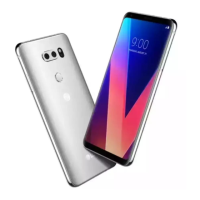
 Loading...
Loading...
Do you have a question about the LG V30+ and is the answer not in the manual?
| Display | 6.0 inches, P-OLED, 1440 x 2880 pixels |
|---|---|
| Processor | Qualcomm Snapdragon 835 |
| RAM | 4 GB |
| Internal Storage | 128 GB |
| Battery | 3300 mAh, non-removable |
| Operating System | Android 7.1.2 (Nougat), upgradable to Android 9.0 (Pie) |
| Dimensions | 151.7 x 75.4 x 7.3 mm (5.97 x 2.97 x 0.29 in) |
| Weight | 158 g (5.57 oz) |
| Water and Dust Resistance | IP68 |
| Headphone Jack | Yes |
| Expandable Storage | microSDXC (dedicated slot) |
| SIM | Single SIM (Nano-SIM) or Hybrid Dual SIM (Nano-SIM, dual stand-by) |
| Network | GSM / HSPA / LTE |
| Build | Glass front (Gorilla Glass 5), glass back (Gorilla Glass 5), aluminum frame |
| Protection | Corning Gorilla Glass 5 |
| Chipset | Qualcomm MSM8998 Snapdragon 835 (10 nm) |
| CPU | Octa-core (4x2.45 GHz Kryo & 4x1.9 GHz Kryo) |
| GPU | Adreno 540 |
| Main Camera Features | LED flash, HDR, panorama |
| Selfie Camera Video | 1080p@30fps |
| Loudspeaker | Yes |
| WLAN | Wi-Fi 802.11 a/b/g/n/ac, dual-band, Wi-Fi Direct, DLNA, hotspot |
| Bluetooth | 5.0, A2DP, LE, aptX HD |
| GPS | Yes, with A-GPS, GLONASS, BDS |
| NFC | Yes |
| Radio | FM radio |
| USB | USB Type-C 3.1 |
| Sensors | Fingerprint (rear-mounted), accelerometer, gyro, proximity, compass, barometer, color spectrum |
| Colors | Aurora Black, Cloud Silver, Moroccan Blue, Lavender Violet, Raspberry Rose |
| Rear Camera | 16 MP (f/1.6) + 13 MP (f/1.9) |
| Front Camera | 5 MP (f/2.2) |
| Main Camera Video | 4K@30fps, 1080p@30/60fps, 720p@120fps, stereo sound rec. |
| Models | H930, H930G, US998, VS996 |